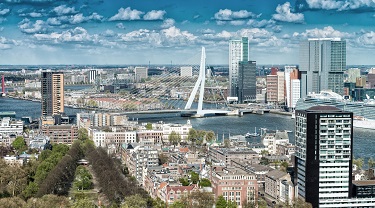As e-commerce exporters know, Europe is a great market with enthusiastic consumers. But they’re also demanding—they want their purchases fast and are demanding shorter and shorter wait times. Next-day delivery and free returns across Europe are increasingly becoming the norm. Given these trends, Canadian exporters need to be responsive to succeed. Using the Netherlands as a gateway to e-commerce in Europe is an effective way to do just that.
Europe is an e-commerce haven
Statistics from the Holland International Distribution Council show that 268 million Europeans shopped online in 2018, spending a total of 198 billion euros ($289 billion). In the same year, 200 million Europeans made online purchases from abroad, which bodes well for Canadian e-commerce exporters. One way for Canadians to capture part of that market is by warehousing in Europe.
At Holland International Distribution Council, we help North American companies with their logistics setups and one-third of our customers are in e-commerce. The council is a non-profit that studies what consumers want and then helps exporters give them those options. Europeans, for example, don’t want taxes and duties that have to be paid at their doors, so exporters need to incorporate them into the price. These demanding consumers also want delivery in a maximum of two days.
A lot of the companies we work with are able to make that two-day rule. They want to service the customer as they desire it. They want a local fulfillment centre in Europe, so they can meet their orders cost effectively and make returns easier as well.
You should also check out
Building relationships is the key to success in international markets—but finding the right contacts takes time. EDC InList connects you to service providers you can trust.
Why you should consider the Netherlands
As e-commerce exporters know, Europe is a great market with enthusiastic consumers. But they’re also demanding—they want their purchases fast and are demanding shorter and shorter wait times. Next-day delivery and free returns across Europe are increasingly becoming the norm. Given these trends, Canadian exporters need to be responsive to succeed. Using the Netherlands as a gateway to e-commerce in Europe is an effective way to do just that.
The Netherlands is Canada’s fifth-largest export market in Europe and its 11th globally. In addition, the country is a growing e-commerce hub. Several factors play into that growth, including its:
- well-developed port facilities;
- central location;
- customs and other border procedures;
- quality of transport and IT infrastructure for logistics;
- ease of use and affordability of shipping; and
- the level of professionalism in the Dutch logistics industry, which has been at the top of the World Bank Logistics Performance Index for several years.
The Comprehensive Economic and Trade Agreement (CETA) between Canada and the European Union also helps Canadians export to Europe. Most products manufactured in Canada are duty-free in Europe, allowing Canadian products to compete on a level playing field with European products. Non-tariff barriers such as regulatory conditions have also been simplified in CETA.
Canada Goose is one company that’s jumped on Europe’s e-commerce wave and its European fulfillment centre is based in the Netherlands. After a European consumer makes an online purchase, everything is outsourced to a logistics company in Rotterdam, Holland. The logistics provider sends the products to consumers, organizes the returns and does quality control since many of the products are made in China and shipped directly to Rotterdam.
It’s a mututally benefitial relationship between Canada Goose and the logistics company. It always takes time to find the right partner. Exporters want to know how to get their products to their e-commerce clients with cost efficiency. That’s where we help. We tell them how it works, what you have to think about, common pitfalls and how to find the right partner.
What exporters need to know
The e-commerce industry in Europe tends to be domestically focused, so early on, cross-border shipments were only getting a small part of that business. But that’s growing more and more as a result of exporters setting up shop where the consumers are.
Europeans want their products within one or two days, so shipping from Canada directly to consumers won’t work. A fulfillment centre makes sense. In the Netherlands, that centre would situate you between the three biggest e-commerce markets—Germany, France and the United Kingdom. If you want to build up stock in Europe, being in one spot makes sense and having that in a central location is best.
Exporters should also know that most Dutch people speak English. In fact, the Netherlands is the No. 1 English-speaking country in the world after native English-speaking countries such as Canada. Those with fulfillment centres in the English-speaking U.K. will be facing regulatory issues once Brexit takes effect.
We see a move of fulfillment centres from the U.K. to the mainland, especially from companies in North America, Australia and New Zealand. They used to be heavily involved in the U.K. because they have the same language, they’re culturally close and it feels familiar. Up to now, it worked. After Brexit, it’ll be a different story.
As a result, a number of Canadian companies have already moved their fulfillment centres to the Netherlands.







